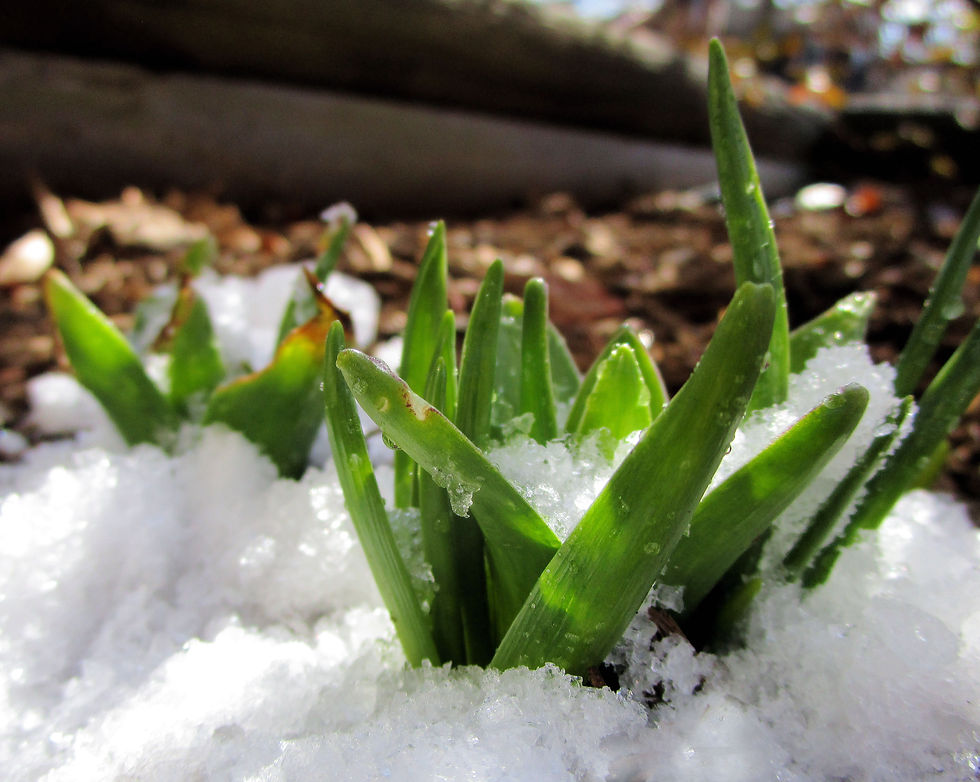Combat Cold Weather Blues With These Winter Gardening Tips
- Black Girls Gardening In Containers

- Dec 25, 2023
- 4 min read
How container gardening can help to combat Seasonal Affective Disorder (SAD) in colder winter climates.

Seasonal Affective Disorder (SAD) is a type of depression that occurs around the same time every year, usually in the winter months when days are shorter and there is less sunlight.
Symptoms of SAD include feeling depressed, having low energy, a craving for carbohydrates, changes in appetite, difficulty concentrating, sleeping too much, and feeling irritable or overwhelmed.
A study from Sweden found that women are at higher risk of seasonal depression than men. Women may be more likely to experience these symptoms because of hormonal changes and the potential for stress associated with increased workloads or family responsibilities during the winter months.

Treatment recommendations for Seasonal Affective Disorder include light therapy, medications, lifestyle adjustments, and psychotherapy.
However, one lesser-explored way of getting through the winter blues is container gardening and indoor plants. We need healthy and positive ways to deal with the depression of the winter months, and gardening is one such activity that can help.
Why do plants play an important role in mental health?
Plants can provide a sense of connection with nature, which can help people feel more relaxed and calm. Being around plants and greenery can help reduce stress, improving overall mental health. You can definitely combat cold weather blues with these Winter gardening tips.
Container gardening is an ideal hobby for those suffering from winter blues, as it offers a number of potential benefits.

● Gardening has been found to have positive effects on mental health. Studies have found that gardening can reduce stress, improve self-esteem, and improve overall well-being. Gardening has also been linked to reducing symptoms of depression, improving short-term memory, and helping to reduce anxiety.
● Gardening can be an enjoyable activity that helps one stay physically active, and can also provide an opportunity to learn new skills and gain knowledge. Furthermore, gardening can also provide an activity that encourages social connections and a sense of community.
● Plants can provide the physical and emotional benefits of caring for something, which encourages a sense of accomplishment for many people living in cities. Container gardening can be done indoors or outdoors, making it accessible to those who may not have access to traditional gardening space. It also allows you to create a cozy and inviting atmosphere that suits you.
We’ve established that plants contribute to a positive mental outlook and mood, so take advantage of indoor and outdoor container gardening opportunities during the colder months. Your winter container garden can be enjoyed on decks, patios, sunny window sills and porches.
They also do very well indoors with grow lights if you don’t have the space.
Make the most of your container gardening in winter
1. Choosing plants for winter container gardening
● Choose low-maintenance plants that can withstand cold temperatures
Hardy plants like pansies, violas, primrose, winter daffodils, and cyclamen can bloom in cold winter temperatures. Evergreens, such as holly, juniper, and yew, can add color and texture to your winter garden. Perennials, like mums, heather, and sedum provide a nice transition into the winter season.

● Start edible plants in spring and summer
Planting edible plants like herbs, tomatoes, or lettuce will not only provide mental and emotional health benefits but can also supplement a healthy diet in winter when fresh produce is scarce and you need more multivitamins. They will be a tasty reward for your gardening efforts.
● Grow plants that require less sunlight
Growing plants that require less sunlight in your container garden can help combat seasonal affective disorder during the winter months. This is where ornamental plants like pothos, snake plants, ZZ plants and some ferns like asparagus Ferns come in very handy. They all require minimal light and some moisture but can survive less sun, and you can fuss over them in winter (take cuttings, mulch and fertilize, etc) without doing much damage - if you don’t overwater them.
2. Choosing a winter container location
● Shelter plants from harsh winds
Move potted plants to sheltered locations if temperatures dip below freezing. This will protect against wind and frost damage. You can also add protective material to repel rainwater or harsh winds to protect smaller plants.
This is why container gardens are so versatile. You can change your garden’s location based on the weather conditions so they get the maximum light and shelter they need to thrive.
Choose a sunny spot
Ensure the container chosen has plenty of sunshine - the rule of thumb is to get at least 6 hours of sunlight - to thrive. A south-facing window is ideal in the winter months.
If a sunny spot is not available, use a reflective material to direct the light.
3. Accessorize for a visual boost
Add bright and colorful accents to your garden to provide both visual and emotional stimulation during the drab winter months. Consider adding accessories to help warm up your outdoor space like sculptures, wind chimes, decorative twinkle lights, or big, bright faux-flowers to your winter container garden.
Some visually pleasing but practical gardening accessories for winter include:
● Lanterns
● Fire pits
● Outdoor rugs
● Decorative containers
● Bird feeders
● Birdhouses
● Statues
● Fountains
● Wind chimes
Just having a space where you can hang out with your plants and a soothing cup of coffee is sure to boost your mental outlook and help combat the winter blues.
Gardening is therapeutic and can be a rewarding hobby to help combat Seasonal Affective Disorder. Plants can provide mental and physical benefits that aren’t possible in traditional gardens. Container gardening can be done indoors, allowing access to the benefits year-round. Container gardens can be tailored to any size and space, allowing for maximum flexibility during the winter months.
So this winter, why not give container gardening a try?





Comments